
Sleeping next to someone has enormous health benefits, beginning with reducing stress and strengthening our immune system. Yet psychologists are also certain that sleeping positions will reveal a lot about the partners ‘ relationship and point out the unspoken problems. So it’s time to find out what our unconscious is trying to tell us and see how it is reflected in our everyday lives.
1. Spooning

Spooning is a very intimate and relaxed place, providing a great deal of emotional support and skin-to-skin touch. The partner who acts like the “big spoon” is likely to be a very supportive and giving person, while the “little spoon” really loves this security feeling, but in a relationship may need some extra care. To sleep in this position means that spouses can rely on each other and have managed to create for themselves a safe environment.
This spooning position is good for both partners ‘ health as it does not put backpressure and helps to ease snoring. Partners should take care of their shoulder and knee joints, however, and ensure that they are
2. Intertwined
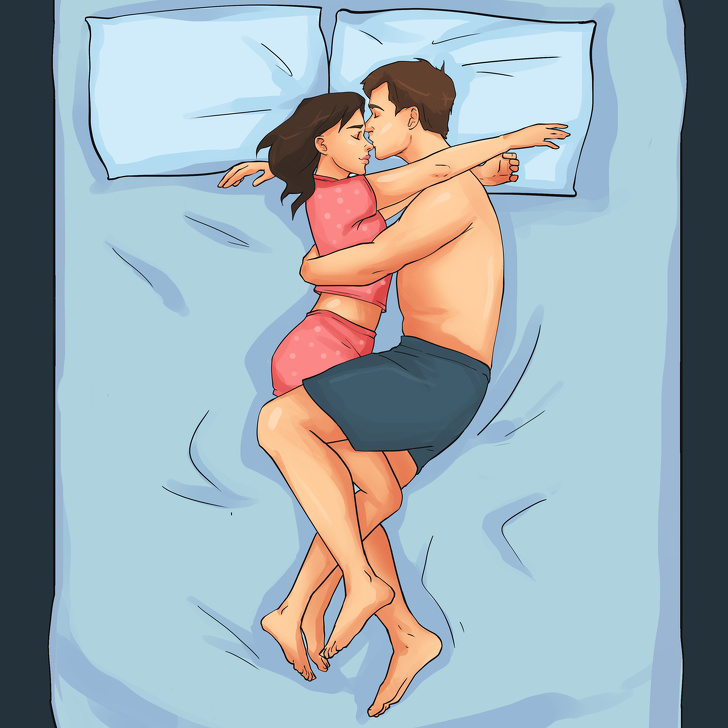
This is a very sensual pose that looks like a close embrace. During sleep, being completely entangled is normal among new couples, even in their sleep, who still can not keep their hands off each other. Couples who have been in a long-term relationship rarely sleep this way, but if they do, it can be a sign of great love or a sign of co-dependence in a relationship.
This is not the safest sleeping position in terms of health, despite being very romantic. Close physical contact doesn’t leave much space for breathing and partners may suffer from body aches in the morning because of joint stiffness.
3. Back-to-back
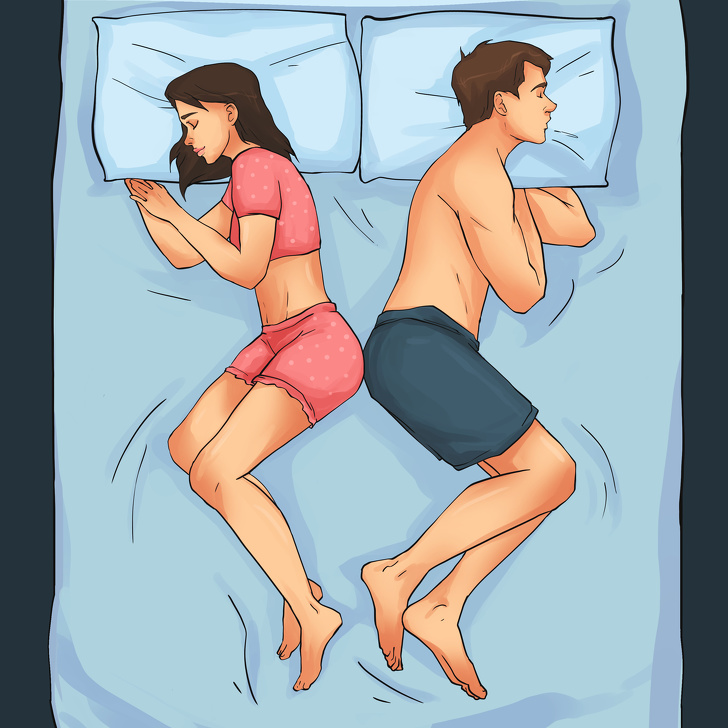
Returning to sleep in a comfortable position that allows both partners to enjoy physical connections but still have their own room. This suggests that a healthy balance exists in the relationship between intimacy and personal autonomy. Partners who choose this role feel comfortable with each other and do not need too much reassurance about their affection, but still want their tender feelings to be shared.
This is a healthy position for their backs as both partners sleep on their side. They can put their hands in any way they like as a bonus. Yet partners with their joints should be careful to avoid aches and pains.
4. Face-to-face without touching
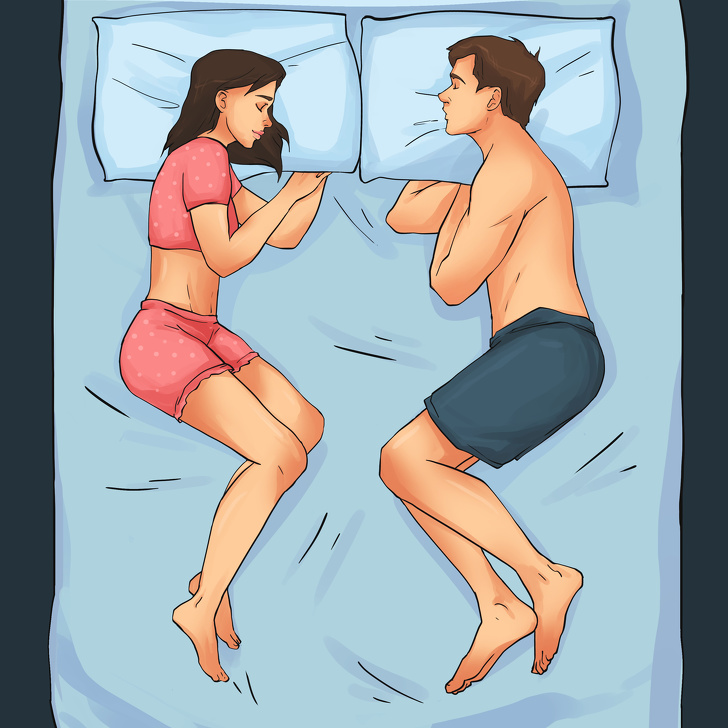
While it may seem like a sign of a problem that there is no touch, this is not always the case. Sleeping in this position may suggest that partners are looking for something more in the relationship, such as affection, intimacy, or interaction, but have not yet obtained it. This need not be a bad thing, especially if partners can listen to each other and grow from that experience.
In terms of physical health, this position is convenient, but spouses should make some effort to minimize any emotional stress. This position is ideal for pillow talk, which can help boost intimacy and foster an open conversation about each other’s feelings and needs.
5. On the chest

Couples that choose this role have a good ability to cooperate and see each other as a group. They trust each other and are willing to face all their problems together, but in their relationship, there is still romance and tenderness. Like spooning, this position displays one of the partners ‘ protective side.
For all the touching love, let’s face it, this is not a very comfortable position. Partners may suffer from limb numbness or stiffness or feel too hot due to close contact between the skin and the skin.
6. On different sides of the bed
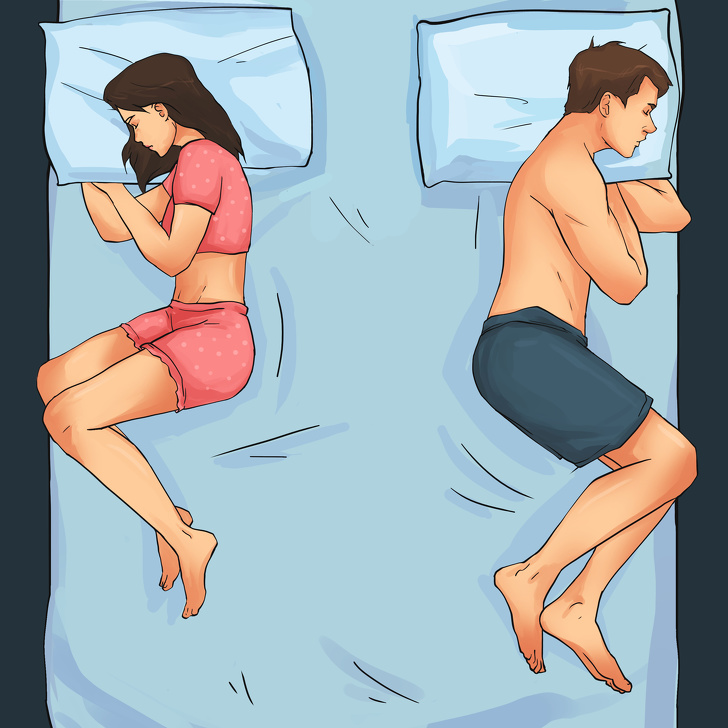
This position, on the one hand, can suggest the partners ‘ independence and self-sufficiency. Nonetheless, the lack of physical contact can point to some of the relationship’s problems and resentment. When partners switch away as soon as they get to bed trying to quickly fall asleep, this could be a worrying indication of an ongoing patent dispute that both partners are troubling.
A high level of stress and depression is demonstrated by the closed body position and the need to sleep separately. Partners distance themselves from the subject and prefer to ignore it rather than talking things over.
7. Starfish
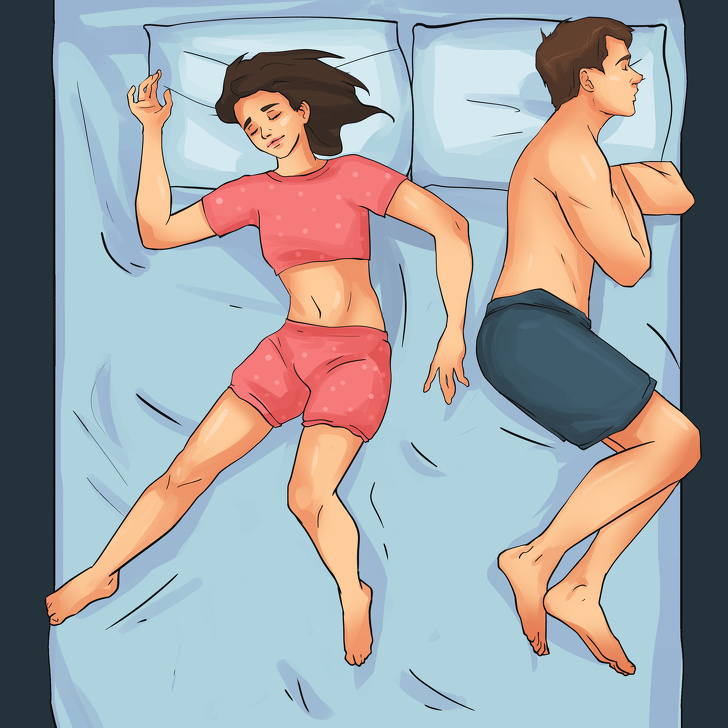
This role is convenient for the person acting as the “starfish” while giving the other partner a lot of discomfort. The “starfish,” leaving the other partner on the edge of the bed, takes up all the space. This sleeping position may suggest how the roles in the relationship are distributed: one partner behaves selfishly, taking all the space, while the other tends to compromise and minimize their needs.
The same applies to health benefits. The “starfish” get all the benefits such as relieving back pain and waking up fresh and well-rested. The other partner has to sleep less and have a higher chance to spend the night with a snorer: sleep in this position
8. Both on the stomach
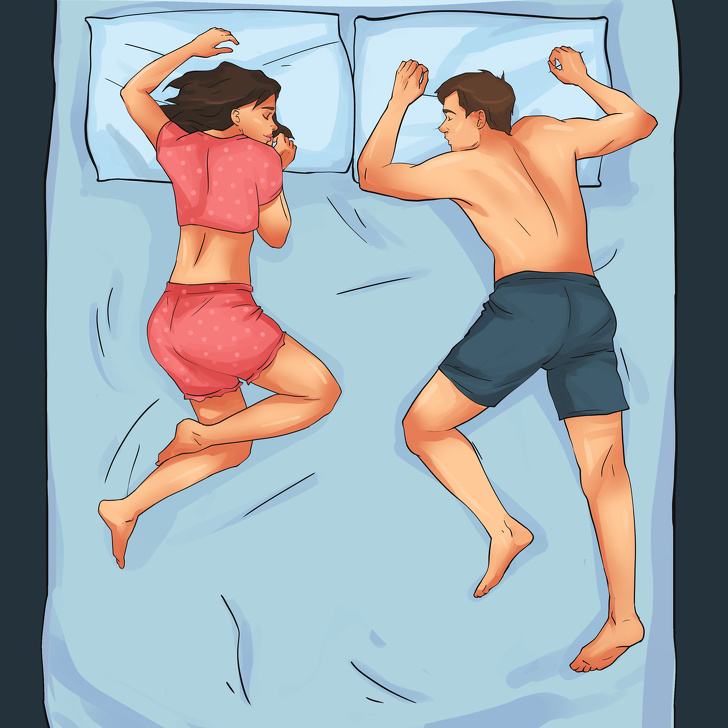
This status can suggest some relationship trust issues. This means both partners are trying to hide their real feelings and cut off the other partner. Partners can combat frustration and anxiety and feel too nervous to express their emotions openly. It’s probably time to have an honest conversation with your partner if you find that this sleeping arrangement becomes a habit.
Moreover, it’s no good at all to lie on the stomach. It puts unnecessary pressure on the spine, especially on the lower back, causing you to turn your head to the side. Put a pillow under your stomach to relieve pressure on your spine if you can’t stop sleeping in this position.
9. Leg hug
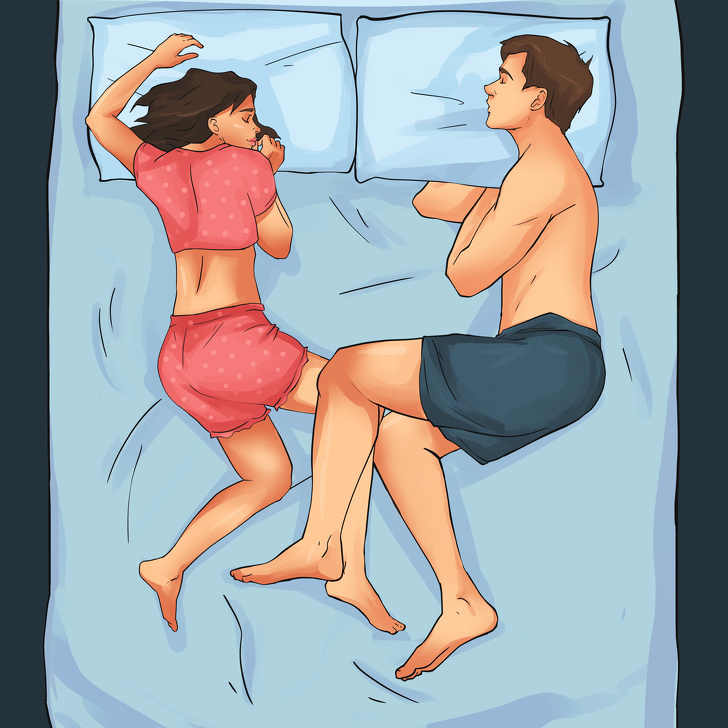
The leg hug is a gentle and tender sign of an emotional connection’s desire. If both partners do this and act responsively, it is a good sign in the marriage that demonstrates passion and love. The spouses see it as a partnership and are committed to each other. But if only one partner does all the touching, it may be the time to assess the relationship dynamic and what each partner brings to the table.
The leg hug provides both partners with a variety of options for sleeping positions so they can both have a good night’s sleep and find the best position for them.
10. Front-to-front
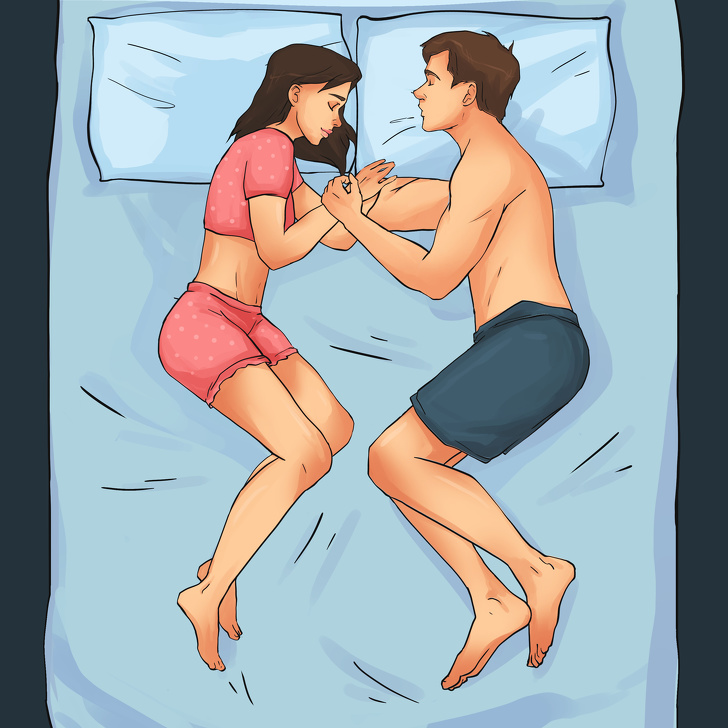
This position is similar to being intertwined, but it gives more freedom to the partners. Sleeping this way shows that the relationship is generally happy and satisfied with the partners. They are compatible with each other and live in harmony. Partners show their closeness, but with constant touch, do not suffocate each other.
Front-to-front sleeping may be perfect for late-night talks, but it may not fit for all couples because most people don’t like sleeping next to someone breathing in their face all night.
11. Head on the shoulder
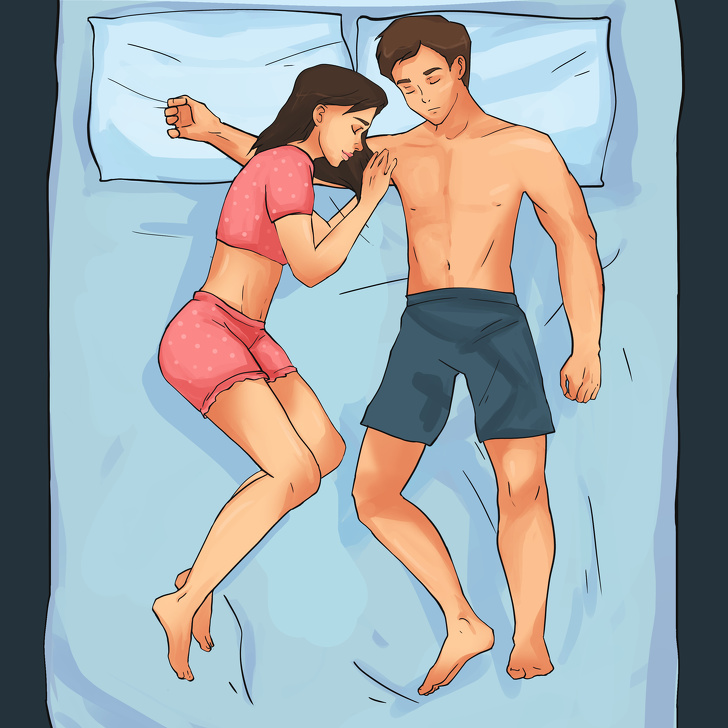
This position is very similar to your partner’s sleeping chest, but it has a different atmosphere. It shows that one partner is acting as a protector who is always there to provide some support, while the other partner is relying on help. It shows that one partner is more dominant, but in a healthy manner, and partners are confident in their feelings and love-filled.
There are some disadvantages to sleeping in this position, like all other positions where partners are too close to each other. Thanks to an awkward limb location during the night, there is a high chance that the spouses will wake up with body aches.
12. Tetherball
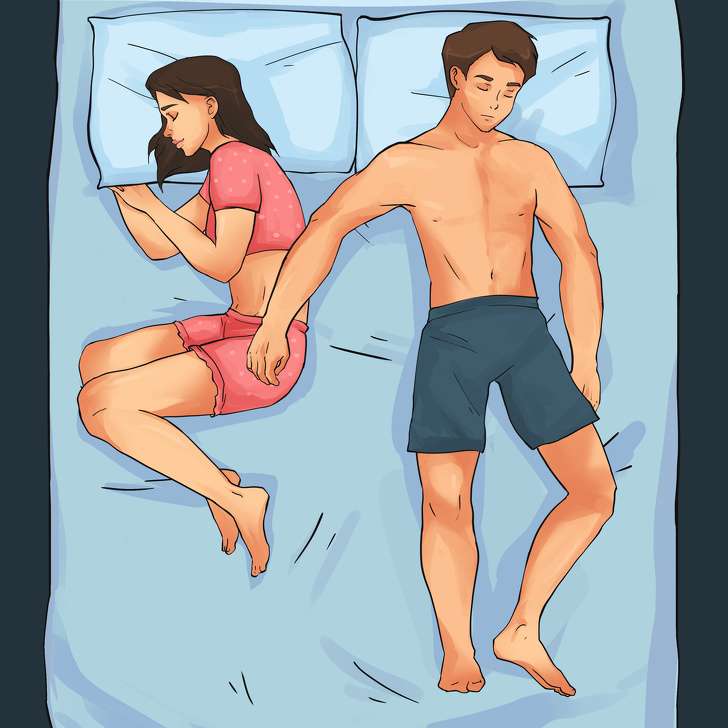
Tetherball is great for people who like to sleep or turn in different positions during the night but still want some physical contact. For example, when sleeping in the fetal position, one partner will sleep on their back and put their hands on the other partner’s back. It shows that partners care for each other and are willing to compromise in order to meet the needs of each other.
Such couples want to express their love to their partner endlessly, but with their care and attention, they don’t want to suffocate them. This position provides all partners with a good night’s sleep and needs little change.
Illustrated by Alena Tsarkova
